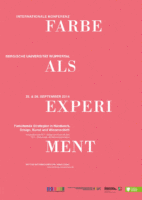Teaching design on the brink?
Conference and teacher training with lectures, discussions and exhibitions on 27. and November 28, 2014 in Regensburg
The event is a prelude to the transnational congress of art education 2015 at the Mozarteum Salzburg entitled“Blind spots in art education“.
Key question of the event
What can the systematic promotion of design at schools, colleges and universities achieve in the context of science and media-based education?
Aims of the event
Subject-specific and interdisciplinary engagement with the teaching of design through the presentation and discussion of the perspectives of teaching, application, research and art
Place
Art Gallery of the University of Regensburg
Universitätsstraße 31; 93053 Regensburg
Download flyer conference program GESTALTEN lehren auf der Kippe
More information about the event and registration:
Abstract lecture
Verbal and spatial-visual language and media skills have developed from the gestural origins of cultural history to the digital practices of the present day in a cross-generational educational process. Media-specific knowledge, abilities and skills for perceiving, communicating with and shaping the environment are reflected in the lifelong development process of the human brain, whose plastic behavior enables every individual, regardless of their background, to actively participate in shaping modern societies.
The illustrative works of nature and culture are “open books and libraries”, interdisciplinary and cross-cultural collections of knowledge and motivational sources of innovation, as soon as we systematically develop the genetically inherent human perceptive faculty in the sense of complex reading and comprehension skills. Each generation can still discover many “unwritten pages” in these vivid stories, “write on” them themselves, “rewrite” them and add “missing chapters”, provided we promote the necessary media-specific presentation and design skills in terms of content and methodology.
While word language can stimulate and support the process of shaping the environment, descriptive “reading and writing” or “interpreting and representing” is only possible in the form of analog and digital images, films, animations, sculptures, products, models, machines, acting, dance and architecture. As lesions in the brain show, the “world in the head” or the ability to think and imagine is organized in a media-specific way, which is why links between colors, sounds, smells, shapes and movements must be systematically created. A transfer of knowledge and methods for solving problems in theory and practice is only possible insofar as we can harmonize the form of our thinking with the forms of our actions.



